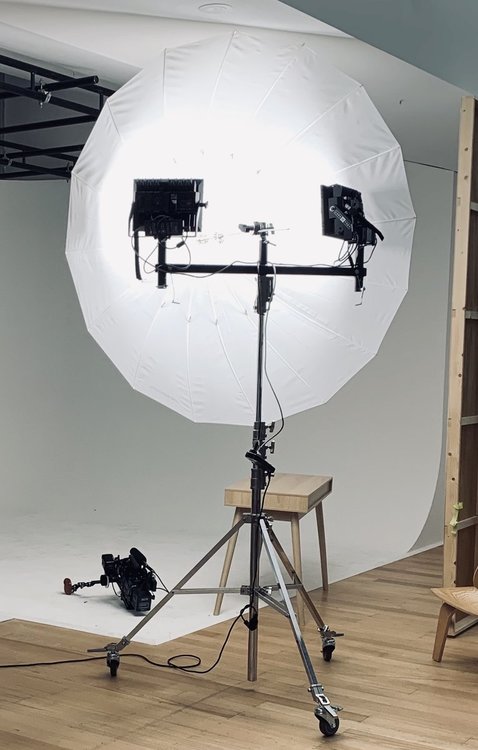-
Posts
1,536 -
Joined
-
Last visited
Posts posted by Mark Kenfield
-
-
A 2/3" cinema camera is a very niche product these days. Personally I think $5k is a reasonable amount for any tool that capable. You're operating at such tiny percentages of the original purchase value, that it's really just a question of what an interested party would pay.
For anyone with a tidy set of some of the amazing 2/3" glass that came out around the same time (Digiprimes, Fuji Zooms etc.) I think it'd be well worth it. -
For a very on-the-nose sales pitch (for a product that's of no interest to me personally) it actually managed to hold my attention for the whole three minutes! Well done Sat, looks really polished.
Did you find the S360 sped things up much (by being a mid-sized source in and of itself)?-
 1
1
-
-
7 hours ago, David Mullen ASC said:
I would guess that a typical anamorphic lens would cover a 24mm height since most cover a 24mm width.
In hindsight, that seems pretty bloody obvious all of a sudden! ?
-
What David said.
Some S35mm anamorphics will give you a little more leeway though. The Master Anamorphics for example, can cover the full height of the LF sensor down to the 28mm(!), you won’t get the full width of the sensor, but you can get a full-height 2:1 extraction.
So 3096x3096, or a 1.43x difference (which isn’t insignificant).
-
22 hours ago, Robin R Probyn said:
Steady tiger... too much of that without a beer and they'll take your passport away ..
Fortunately I didn't have to go beyond those two calculations!
It's a weird feeling though - googling "exposure/lighting/photometric/footcandle calculator" for ten minutes without success, then realising if you walk 4m over to your bookshelf and the trusty old ASC manual, you can figure it all out the old-fashioned way.
It was kinda shocking to realise how rarely I interact with real books, and physical paper and pen these days.-
 1
1
-
-
I'm feeling pretty legit this evening...

Flexing my cinemathography muscles. -
I looooove a good, creepy zoom.
-
 1
1
-
-
I love a good superwide when there's cause for it. My favourite focal length (if I had to pick one) is probably a 21mm (on S35mm), which seems to be about as wide as you can go without perspective distortion starting to make things look weird.
But there's so many interesting things you can do with an ultrawide perspective. -
-
33 minutes ago, Philip Reinhold said:
Wonder why nobody has mentioned a used Sony F65 before... I think she is superior to an amira and much cheaper in the used market these days. You can get them for around 5K and it's a wonderful real 4K digital camera with mechanical shutter and a very cinematic exposure latitude, netflix approved and rock solid. EX-Machina, Oblivion… there are many visually stunning movies shot on it recently…
Because (up against the Amira) you're comparing one of the easiest cameras (to physically work with on set) with one of the most complicated.
The F65 is an imaging beast, but it's also a bit of a beast to work with. I've come close to pulling the trigger on one several times (the price is certainly right!), but the compressed codecs don't let you use variable framerates, and the raw files are very large. So it's a bit of an all or nothing camera. -
I've always found Alexa/Amira footage a bit noisy at it's native 800 ISO. Not in any objectionable way, but it's very clearly there in the shadows.
At 400 ISO though (which is where I'll generally shoot the camera unless I'm short on light) I'd consider it SQUEAKY clean.
Can you post some examples?
I general, I'd always be wary of underexposing digital images. By which I don't mean placing things in the shadows, but rather putting anything in a situation where you're going to have to lift the shadows in post. A one-stop push is rarely a problem, but by two your always into nasty territory. -
At the expendables suppliers here in Oz, we have "camera covers" which are just big clear plastic "bags" (essentially), which we just cut holes in, where needed, for monitors, evf etc.
A bit of tape around the edges of the cuts (to help reinforce them a little) helps a lot. And if you really want to go all out - velcro strips along the bottom to hold the "opening" of the bag together is pretty tidy (most of the time we just use tape or clamps.
Here's an F35 with the bag treatment: -
1 hour ago, Michael LaVoie said:
That argument which everyone tries to use doesn't hold up when you're talking about a single use event such as renting a camera for a production. Pick up a digital camera or a film camera, what is going to be more wasteful for that one production? Pretty simple.
Not talking about the endless disposable consumer cameras both film and digital produced over the years. Planned obsolescence is a separate issue and a huge problem across many industries that's much too broad to unpack here.
Not really, because the single usages that we're individually responsible for aren't the issue (beyond simple, personal feel-good metrics) - it's the sum total of the waste generated by each medium that matters (for the sake of comparison/overall environmental impact and sustainability).
I have no ideas what those respective numbers would be, but I'd be fascinated to know. -
Just now, Michael LaVoie said:
Dreaming of shooting film is all fine. But shooting it isn't very green. Lots of wasted materials, chemicals, etc. Best to shoot on Digital since IPCC reports lately say our near future is looking more and more like this:
What human endeavour isn't? It the nature of consumption, it's a destructive process.
The chemical output and waste from photochemical processing sure as hell wasn't a nice thing. But I do wonder how it compared to the overall natural cost of digital, where the devices become obsolete and discarded so much more rapidly than mechanical film cameras ever were. -
2 hours ago, Tyler Purcell said:
I don't think the 2000 revolution was THE revolution. I think some cinematographers meddled with Digital for fun, trying new toys, which they've always done.
I think the revolution happened between 2008 - 2014 (6 years) the industry went from predominantly film acquisition and distribution, to predominantly digital acquisition and NO film distribution.
I'd agree with this.
I'm of that lucky generation that studied purely photochemical photography through school and university, to emerge out into the real world in 2008... to the GFC, the Red One and the 5D Mkii ?
I don't know if I could have timed things much worse if I'd tried!-
 1
1
-
-
Can we let each other dream without the "constructive" criticism?
-
 2
2
-
-
For me, I think it’d be 5-perf 65mm on the 1.25x Ultra Panatars from Panavision. It has the most incredible look, and I prefer the workflow of film on-set. Things are done less by committee, and people respect when the camera is rolling.
-
 1
1
-
-
Selling my set of five SWIT S-8U63 63W/hr BP-U compatible batteries for the Sony FS7, FS5, F3 and the upcoming FX9 (along with the PMW-150, PMW-200, PMW-300, PXW-X200, PXW-Z190, PXW-Z280, PMW-EX3 and PMW-EX1R too).
I used these with my Sony F3 and they’re terrific, they include both a DTAP and USB output for powering all of your onboard accessories, and they keep the form factor of the camera so much smaller and lighter than adding V-mount batteries does.
The kit includes a Sony BC-U2 Dual Charger and a custom-cut Pelican 1400 case to store it all.
They’re three years old and have seen pretty minimal use, so they’re in excellent condition.
$825 USD for the kit.
Located in Melbourne, Australia. But happy to ship worldwide (though being lithium batteries there are some restrictions on the shipping methods available).




-
Great video. Frieder from Kino Flo does an EXCELLENT presentation on all this that he's toured around the world a bit, that clarified a lot of these spectral issues for me.
The part I don't quite understand is why the LEDs that have enough spectrum for a good result with gels, can't simply limit that spectrum to a level that would match their gelled performance (as gels are only removing parts of the spectrum, not adding to them).
I assume that it's because the LED emitters are a bit too blunt of an instrument for that, and when you reduce (for example) green, you're reducing all of your green, rather than just the specific portions that a particular gel could block.
I do wonder though, whether reducing your green proportionally (so that some of your green emitters are lowered, but some remain pumping out their full spectral compliment) might help with that?
-
Looks luscious Miguel, I still don't know how you manage to get away with 3200 ISO on the Alexa - my pictures just turn to mush, but yours look lovely!
Post up the full film when you can, I'd love to see it.-
 1
1
-
-
On 10/5/2019 at 7:57 AM, Gregory Irwin said:
It was very complicated photography (6K at a T1.3 to a T2) and we were much more successful at it than we would have been had we shot on film.
G
Ouch!
How the hell did you manage it Greg? I imagine that would be a nightmare without something like the Lightranger 2 onboard.-
 1
1
-
-
You’ll be able to find some. But it’ll be ooold. So you have to decide if it’s worth the risk.
-
20 hours ago, Tyler Purcell said:
The moment someone comes out with a PL mount replacement on the 6k, I will buy one. Until then, EF is pretty useless for me, so I'm personally holding off. If you have EF glass, I'd go for it tho.
I thought there were multiple companies offering PL mount conversion kits for the 6k?
-
I've heard multiple reports of power-related issues with the Venice to-date, bit disconcerting with a $100,000 AUD camera.





I want to develop a new lighting technology for my PhD. Any suggestions?
in Lighting for Film & Video
Posted
I’d love to see a thin but wide-aperture source, with a tight beam.
Something the size of a Kino tube, in 2’, 4’ and 8’ lengths, but with a tight beam (something like a 20 degree beam angle, or even tighter).
Combining the wrap of a tube light, with the control of a spotty source would be quite unique. And so much more controllable than a Kino/Quasar tube.